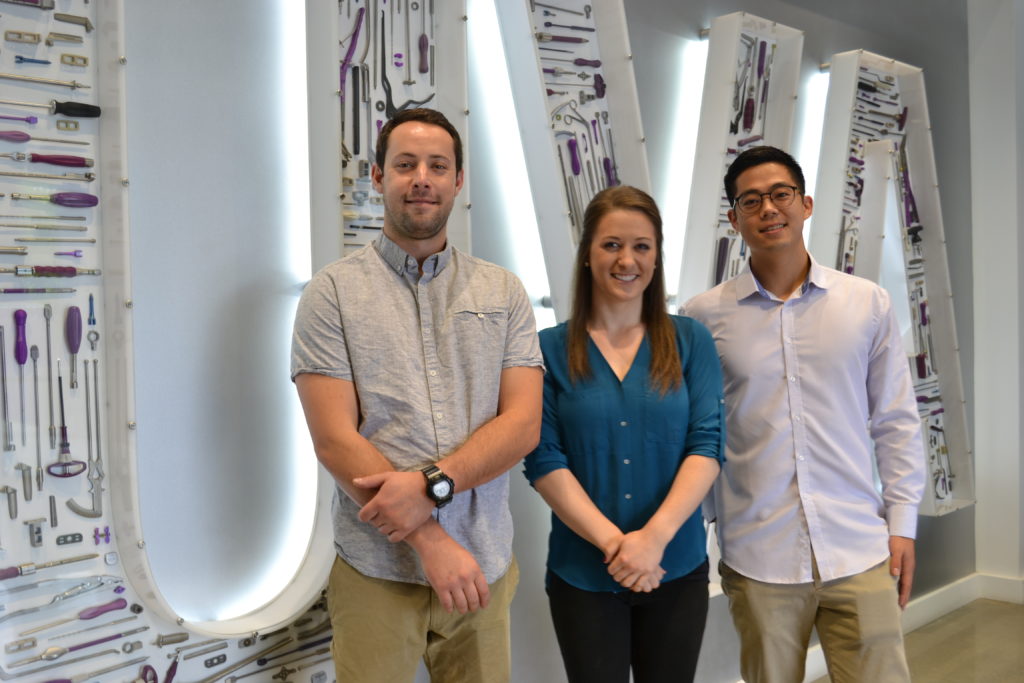We’re featuring RELINE® Small Stature innovators, Hayden, Adam, and Julia, to give you an inside look into what it’s like helping drive innovation at NuVasive. Historically, surgeons have had to compromise rod fatigue strength for pediatric-sized implants. RELINE Small Stature is the first pediatric deformity fixation solution that combines rod strength with low-profile implants, including:
- One low-profile 12.9mm tulip that accepts 4.5, 4.75, and 5.0mm rods in Ti and CoCr, and
- Instrumentation with improved tactile feedback to help optimize implant placement
Read their interview below:

What sparked the need for RELINE Small Stature?
- Hayden & Adam, Engineering: RELINE Small Stature was driven by market analysis that identified a critical need and opportunity for better innovation in the pediatric space. From an engineering perspective, we saw a need to deliver lower-profile implants, introduce pediatric-specific instrumentation, and address the shortcomings of competitor designs.
- Julia, Marketing: When NuVasive made the decision to enter the Pediatric market, we developed a full market plan. The first step of this plan was the Ellipse (NuVasive Specialized Orthopedics™) acquisition to provide magnetically-controlled growing rods to patients. These MAGEC® rods are designed to reduce planned distraction surgeries. The second step was creating a fixation system for the pediatric MAGEC rod sizes. That’s where RSS came into play!
What were the resources needed to start this project?
- Hayden & Adam: Our brilliant design surgeon team was one of the key elements of this project that allowed us to pioneer a truly differentiated pediatric system. Also, the marketing team visited pediatric cases firsthand to identify areas of improvement for instrumentation and implants. With our design requirements in place, our development team focused on brainstorming, designing, and iterating upon concepts. Our talented machinists fabricated several prototypes in our in-house machine shop, allowing us to quickly iterate and evaluate our system early in the project.
- Julia: An innovative engineering team and a passionate surgeon design team. We knocked this project out in 15 months from kick-off to evaluation launch!
Usually the first idea might not be the greatest idea. Was the original idea for RELINE Small Stature what it is today? If it has changed, what necessitated the change?
- Hayden & Adam: As with any project, the design of our system evolved throughout the different phases of development. Our marketing team consolidated and analyzed surgeon feedback data from our cadaver labs and alpha evaluations, helping us identify design enhancements to better meet the requirements for the RSS system.
- Julia: Because of the success we have seen with our RELINE system, we had higher confidence in our evaluation launch, choosing to go into it with a greater number of sets than would be typical for an evaluation. We have spent the last year gathering feedback on the system and will be implementing changes into the commercial launch. We are committed to providing the best pediatric solution and continue to seek out feedback to get us there, but also were pleasantly surprised at how close we got on our evaluation.
What was your favorite part about the design and marketing process for RELINE Small Stature?
- Hayden & Adam: Creating a versatile fixation system tailored for smaller, younger patients hits especially close to home for all of us. Though facing the challenges of designing a pediatric system was very exciting, it all pales in comparison to seeing the direct impact we had in changing lives every day.
- Julia: NuVasive supports patient and family education events, and being at these events brings it all home. Seeing the direct impact and hearing from patients how their lives have been changed is incredibly fulfilling. Especially knowing that I played a direct role in that.
What skills did you have to acquire to be able to create RELINE Small Stature?
- Hayden & Adam: It was critical for us to gain a better understanding of not only the variety of complex deformities and medical conditions unique to pediatrics, but also the limitations of the existing pediatric systems currently on the market. With this in mind, our engineers attended pediatric deformity trainings led by pediatric spine surgeons and our marketing team to better understand the nature of these surgeries today.
- Julia: The first step was understanding that the pediatric spine world is extremely different than the adult spine world. We had to invest time into understanding the market, the history of surgical techniques, the tools currently being used to treat pediatric patients and their limitations, and the long-term partnership the surgeons create with patient families. Once we had a good understanding of these things, we worked very closely with our incredible surgeon design team and our engineers to create a system that is a truly innovative solution.
View a few of our other Innovator Interviews: XLIF® Crestline™, Modulus® XLIF, Lateral ALIF™, and MAS TLIF/TLX.
If you’re interested in becoming part of the innovation here at NUVA, search our open roles here.
